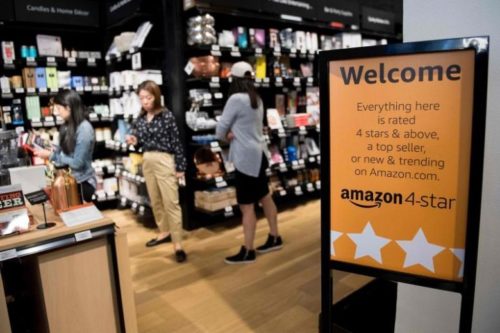Amazon just opened a physical store in New York where all of the products are either highly rated (4+ stars) or top sellers in their eCommerce channel. Brick and mortar competitors should take note of this strategy that is being made possible by the hundreds of millions of shopper-generated ratings and reviews that Amazon customers have come to expect to help them to make informed purchasing decisions. Amazon deduced rather easily that shopper-generated ratings and reviews provide the confidence and context necessary for shoppers to make purchase decisions faster and more effectively than ever before.
Major grocery retailers have all the ingredients necessary to deliver a similar confident shopping experience to their customers. And they don’t even need to be fully invested in eCommerce to enable this capability. Here are a few ways grocery retailers are beating Amazon at their own game:
Mobile Apps with Product Content
Most major grocery retailers have mobile apps that typically promote weekly circular ads and distribute digital coupons. Many of these apps have the ability to scan product UPCs in order to access product pages with images, pricing and nutritional information. Adding ratings and reviews is a simple widget or API call away.
Content-Rich Shelf Tags
Retailers are already leveraging shelf tags to communicate content beyond price. Many grocery retailers now include nutritional value scores, healthy lifestyle identifiers (gluten-free, non-GMO, etc) or available digital coupons on product shelf tags. Grocery retailers can now follow the lead of beauty retailers like Ulta by including ratings so shoppers can see how others have evaluated product performance.
If retailers are disciplined, they can leverage these strategies to further engage even more with shoppers:
New Products Should Come with Content
All new products that grocery retailers list should come with ratings and reviews ready to include in their product pages. At PowerReviews, we work with many manufacturers to launch influencer campaigns via our BzzAgent platform prior to product launch to generate content that can be shared with retailers as their products reach physical stores. The ratings can be easily included on physical displays and on mobile/web product pages.
eCommerce Not Needed to Collect Content
Retailers with active frequent shopper programs don’t need eCommerce to collect ratings and reviews. They already know what their shoppers are purchasing. At PowerReviews, we work with brick and mortar retailers to leverage their loyalty data, targeting shoppers purchasing specific products for which content is needed. We then execute email campaigns to solicit reviews shortly after the store trip has occurred.
Drive Private Label Conversion
One of the biggest obstacles to shopper adoption of store brands is consumer confidence over product quality. Actively soliciting ratings and reviews via targeted FSP campaigns as noted above, coupled with shelf tags and product page placement will accelerate a retailer’s private label penetration efforts.
Maintain an Open Network for Content
Retailers like Walmart, BJ’s, Sam’s Club and Dollar General all participate in an open network of syndicated shopper-generated content in the form of ratings and reviews. Since the content is matched at a UPC or brand level, it ensures that shoppers are exposed to relevant content regardless of where the product was reviewed. In this way, all retailers benefit from a network of content that is related to the products they are selling through their omnichannel mechanisms.
Don’t Be Afraid of Amazon
Amazon is showing its physical competitors how to leverage shopper-generated content to reduce friction on the path to purchase. Grocery retailers have the ability to compete without the need for a fully-scaled eCommerce platform. If they work with the assets already in place, they can mount a credible competitive approach to engage their shoppers and protect market share from Amazon.






